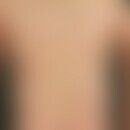DefinitionThis section has been translated automatically.
The term "Pachyonychia congenita" is used to describe a group of ectodermal dysplasia syndromes, usually with autosomal dominant inheritance and varying degrees of cornification disorders of the skin (keratosis palmoplantaris) and mucous membranes, as well as pronounced nail dystrophies. In pachyonychia congenita (type I), mutations in the keratin genes KRT6b and KRT16.
ClassificationThis section has been translated automatically.
Pachyonychia congenita is divided into 4 clinical subgroups according to current knowledge (PC1-4):
- Type I: Jadassohn-Lewandowsky type (PC-1; OMIM 167200) - autosomal dominant mutations in the KRT16 or KRT6A genes (chromosome 17q12-q21). To date, 25 mutations in KRT16 have already been associated with PC. 21 mutations are located on exon 1 and 4 mutations are located on exon 6. (Xu Q et al. 2019)
- Type II: Jackson-Lawler type (PC-2; OMIM 167210) - mutations in KRT6b and KRT17, genes encoding the respective keratins and located on chromosome 17q12-q21 as well as on 12q13.
- Type III: (PC-3; OMIM 615726)- Mutations in KRT6a, a gene located on chromosome 12q13.13.
- Type IV: (PC-4; OMIM 61528) - mutations in KRT6b, a gene located on chromosome 12q13.13.
Furthermore, there is a late-manifested type (Pachyonychia congenita tarda) that resembles either the PC-1 type or the PC-2 type.
You might also be interested in
Occurrence/EpidemiologyThis section has been translated automatically.
Incidence: 0.5-1/100,000 population/year.
EtiopathogenesisThis section has been translated automatically.
Predominantly autosomal-dominantly inherited mutations in the keratin genes KRT6a (gene locus: 12q13) as well as KRT16 (gene locus: 17q12-q21); more rarely autosomal-recessive inheritance and spontaneous mutations.
The described mutations of the keratin genes KRT16 affect the helix initiation motif, a functionally significant segment at the beginning of the helical structure of keratin monomers. These are crucial for the undisturbed formation of keratin filaments. This leads to functional deficits of the keratinocytes, e.g. in response to normal mechanical stress.
Keratin mutations cause the keratin filaments to clump together and can no longer interact with other cytoskeletal structures. This results in a reduced mechanical load capacity of the epithelial dressing.
ManifestationThis section has been translated automatically.
Mostly congenital. Late manifestations between the 10th - 30th year are described according to case reports.
ClinicThis section has been translated automatically.
Congenital claw-like, thickened finger and toe nails. Insular or striated palmar, rarely plantar keratoses (PC1), often hyperhidrosis. Circumscribed keratoses on toes, soles, heels, elbows, and knees. Sebostasis and blistering are possible.
Mucosal changes: Whitish, streaky plaques on the tongue, corners of the mouth, oral mucosa and larynx (leukokeratoses see oral leukoplakia).
Differential diagnosisThis section has been translated automatically.
Congenital onychogryposis
Traumatic nail changes
Twenty-nail dystrophy
Steatocystoma multiplex
Palmoplantar keratoses of other genesis (see below Palmoplantar keratoses)
Epidermolysis bullosa hereditaria
White mucous nevus
External therapyThis section has been translated automatically.
Treat circumscribed keratoses, especially palmar and plantar, with salicylic acid-containing plasters (e.g. Guttaplast plasters) in combination with callus planes or salicylic acid-containing or urea-containing formulations such as R215 or R105. For onycholysis, apply highly concentrated urea-containing topical preparations (e.g. 40% urea paste, Onychomal cream, urea paste 40% ). If necessary, use orthopaedic footwear according to the prescription.
Internal therapyThis section has been translated automatically.
Good results are described with acitretin (neotigasone), initially 0.5-1 mg/kg bw/day, maintenance dose 0.2-0.5 mg/kg bw/day. Relatively high dosage seems to be necessary.
Hyperkeratosis of the skin regresses better than nail changes.
Rapamycin (m-TOR inhibitor) showed an improvement of the symptoms with regard to the keratoses.
Operative therapieThis section has been translated automatically.
Abrasion of the nails. If necessary, surgical removal of the nails including the nail bed.
LiteratureThis section has been translated automatically.
- Bondeson J (1993) Pachyonychia congenita. A historical note. Am J Dermatopathol 15: 594-599.
- Connors JB et al (2001) Delayed-onset pachyonychia congenita associated with a novel mutation in the central 2B domain of keratin 16. Br J Dermatol 144: 1058-1062.
- Hoting E et al (1985) Systemic retinoid therapy with etretinate for pachyonychia congenita. Dermatol 36: 526-528
- Jadasson J, Lewandowski F (1906) Pachyonychia congenita. Keratosis disseminata circumscripta (follicularis), tylomata. Leukokeratosis linguae. In: Neisser A, Jakobi E (eds) Ikonographia Dermatologica, vol 1, Urban & Schwarzenberg, Berlin, pp 29-31.
- Müller C (1904) On the causes of congenital onychogryphosis. München Med Wochenschr 49: 2180-2182
- Scholz IM et al (2011) Pachyonychia congenita type 2. JDDG 9: 144-145.
- Smith F (2003) The molecular genetics of keratin disorders. Am J Clin Dermatol 4: 347-364.
- Steele L et al (2020) Pachyonychia congenita, a paradigm for rare skin disorders. Br J Dermatol 182: 521-522.
- Swensson O (1999) Pachyonychia congenita. Dermatologist 50: 483-490
- Wilson AG (1905) Three cases of hereditary hyperkeratosis of the nail bed. Br J Dermatol 17: 13-14
Outgoing links (4)
KRT16 Gene; KRT6A Gene; Palmoplantar keratoses (overview); Urea paste 40% (nrf 11.30.);Disclaimer
Please ask your physician for a reliable diagnosis. This website is only meant as a reference.




